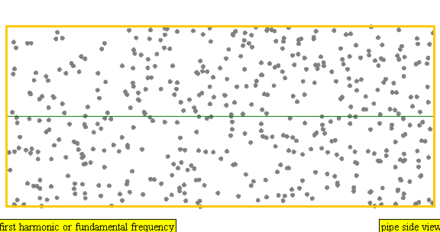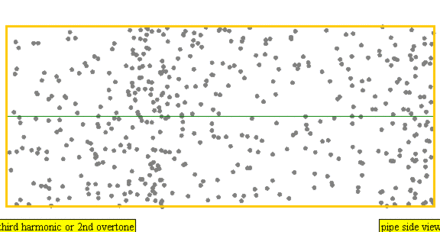Harmonics
In this reading, we are going to explore the concept of Pitch and further examine how changing the pitch of notes can alter the resulting music we produce.
Subdividing a String
First recall that we defined musical tones as vibrations in the air (typically), and that our reference note for concert pitch was A4, which vibrates with a frequency of 440 Hz (440 high pressure peaks per second). We are going to start with this pitch, and use a simple thought experiment to begin deriving other pitches!
Let’s consider a specific example of producing this sound: plucking a string that vibrates at exactly 440 Hz:


*Lookang many thanks to author of original simulation = Juan M. Aguirregabiria author of Easy Java Simulation = Francisco Esquembre, CC BY-SA 3.0 https://creativecommons.org/licenses/by-sa/3.0, via Wikimedia Commons
Now clearly this animation is not vibrating at 440 Hz (since that would be a bit too fast to easily see the motion), but it demonstrates the motion of the vibrating string.
We should note that this figure shows one possible way the string can vibrate when plucked. What is shown is the most natural mode of vibration, what we call the resonant frequency, where the full string sways back-and-forth together. But there are actually other modes of vibration. If we add a fixed point in the middle of the string, we can see that vibrations can form with a wave of half the wavelength (related to the distance between the fixed points) as the previous vibration. Halving the wavelength results in doubling the frequency of the produced pitch.


*Lookang many thanks to author of original simulation = Juan M. Aguirregabiria author of Easy Java Simulation = Francisco Esquembre, CC BY-SA 3.0 https://creativecommons.org/licenses/by-sa/3.0, via Wikimedia Commons
But what is the affect of doubling the frequency on the pitch produced? What new tone have we developed?
If we start with A4 at 440 Hz, doubling the frequency gives us 880 Hz, which we label as A5. Here’s the two played together:
(import music)
(seq (note 69 qn) (rest en)
(note 81 qn) (rest en)
(par (note 69 qn) (note 81 qn)))
Somehow, our brains recognize these as the same note, just one is higher up than the other! That’s why we give them both the label A. We can keep doubling (or halving) to produce other As as well, they go from A0 at 27.5 Hz (the lowest note on the piano) to A7 at 3520 Hz (a little lower than the upper note on the piano, which is C8 at 4186.01 Hz).
Of course, you can continue going up or down in either direction, human hearing just has trouble keeping up. Each time we double or halve the frequency, we say we have moved up or down an octave: A5 is one octave above A4.
The Overtone Series
So we can halve the mode to go up an octave, but what if we try something like dividing our string into three vibrating sections (with 2 fixed points in the interior)? We get a brand new note as 3 times the frequency of the original note!


*Lookang many thanks to author of original simulation = Juan M. Aguirregabiria author of Easy Java Simulation = Francisco Esquembre, CC BY-SA 3.0 https://creativecommons.org/licenses/by-sa/3.0, via Wikimedia Commons
So what is this new note at 440*3=1320 Hz? It doesn’t quite exist in modern western music. It turns out that some of the arithmetic gets weird when we keep going with our subdivisions of the string, and to deal with it, western music settled on a standard tuning that adjusts everything slightly to make the numbers mostly align.
Instead of exactly 3 times the original frequency for A4 (which should be 1320 Hz), we define E6 as 1318.51. It’s pretty close at least! Let’s listen to these notes together:
(import music)
(seq (note 69 qn) (rest en)
(note 81 qn) (rest en)
(note 88 qn) (rest en)
(par (note 69 qn) (note 81 qn) (note 88 qn)))
They sound pretty good together, though that new note is definitely a distinct new pitch.
Here’s an interesting question to ask: what if we take our new E6 and halve its frequency to get what we might call E5? This totally works, and gives us E5, a note with a adjusted frequency set at 659.26 Hz.
What is the relationship between this new E5 and the original A4? We tripled the frequency to get to E6, then halved it to get to E5, so we have a new frequency of 3/2 of the original frequency:
440 Hz * 3/2 = 660 Hz ~ 659.26 Hz (E5)
Let’s hear these notes together:
(import music)
(seq (note 69 qn) (rest en)
(note 76 qn) (rest en)
(note 81 qn) (rest en)
(note 88 qn) (rest en)
(par (note 69 qn) (note 76 qn)) (rest en)
(par (note 81 qn) (note 88 qn)))
But why stop at subdividing 3 times, what if we subdivide 4 times (~A6), or 5 times (~C#7), or more? This is called the overtone series!

*By Moodswingerscale.jpg: Y Landmanderivative work: W axell, Public domain, via Wikimedia Commons
The Western Chromatic Scale
If we continue this process of subdivision, and follow what the western musicians eventually settled on as a standard tuning, you end up with 12 roughly equally spaced notes in a single octave. Below is code that will play these notes for the octave between A4 and A5. This code plays the 12 notes and arrives back at the 13th (the repeated full octave). The names of the notes are provided as comments (some notes have two names, with # pronounced “sharp” and b pronounced “flat”).
(import music)
(seq (note 69 qn) (rest en) ; A4
(note 70 qn) (rest en) ; A#4 / Bb4
(note 71 qn) (rest en) ; B4
(note 72 qn) (rest en) ; C5
(note 73 qn) (rest en) ; C#5 / Db5
(note 74 qn) (rest en) ; D5
(note 75 qn) (rest en) ; D#5 / Eb5
(note 76 qn) (rest en) ; E5
(note 77 qn) (rest en) ; F5
(note 78 qn) (rest en) ; F#5 / Gb5
(note 79 qn) (rest en) ; G5
(note 80 qn) (rest en) ; G#5 / Ab5
(note 81 qn) (rest en)) ; A5
This sequence is called “the chromatic scale.”
Western music is commonly composed by first choosing certain specified subset of these possible chromatic notes and composing music while remaining mostly limited to those notes and the chords that they can produce. We call that type of subset of chromatic notes a ‘scale.’
The most common scale in the western tradition is the Major Scale. Below is the subset of our chromatic notes in sequence which produce the A-Major Scale:
(import music)
(seq (note 69 qn) (rest en) ; A4
(note 71 qn) (rest en) ; B4
(note 73 qn) (rest en) ; C#5 / Db5
(note 74 qn) (rest en) ; D5
(note 76 qn) (rest en) ; E5
(note 78 qn) (rest en) ; F#5 / Gb5
(note 80 qn) (rest en) ; G#5 / Ab5
(note 81 qn) (rest en)) ; A5
We’ll return to this discussion of scales in the future, and explore the western rules of selecting notes to form a scale. These rules are based on the relationship between the frequency of the notes selected. The notes picked for each scale are related to important overtones of the root note of the scale.
Of course, some non-western traditions will require a return to our previous discussion of frequencies and further subdividing of our vibrating string…